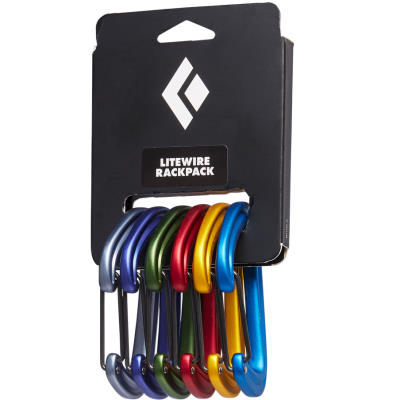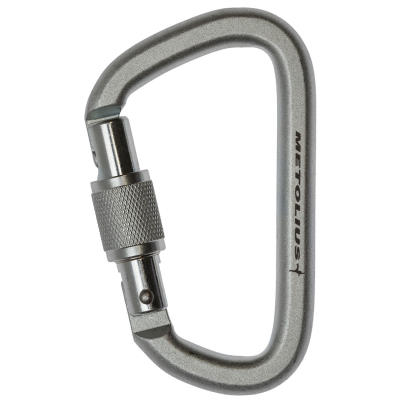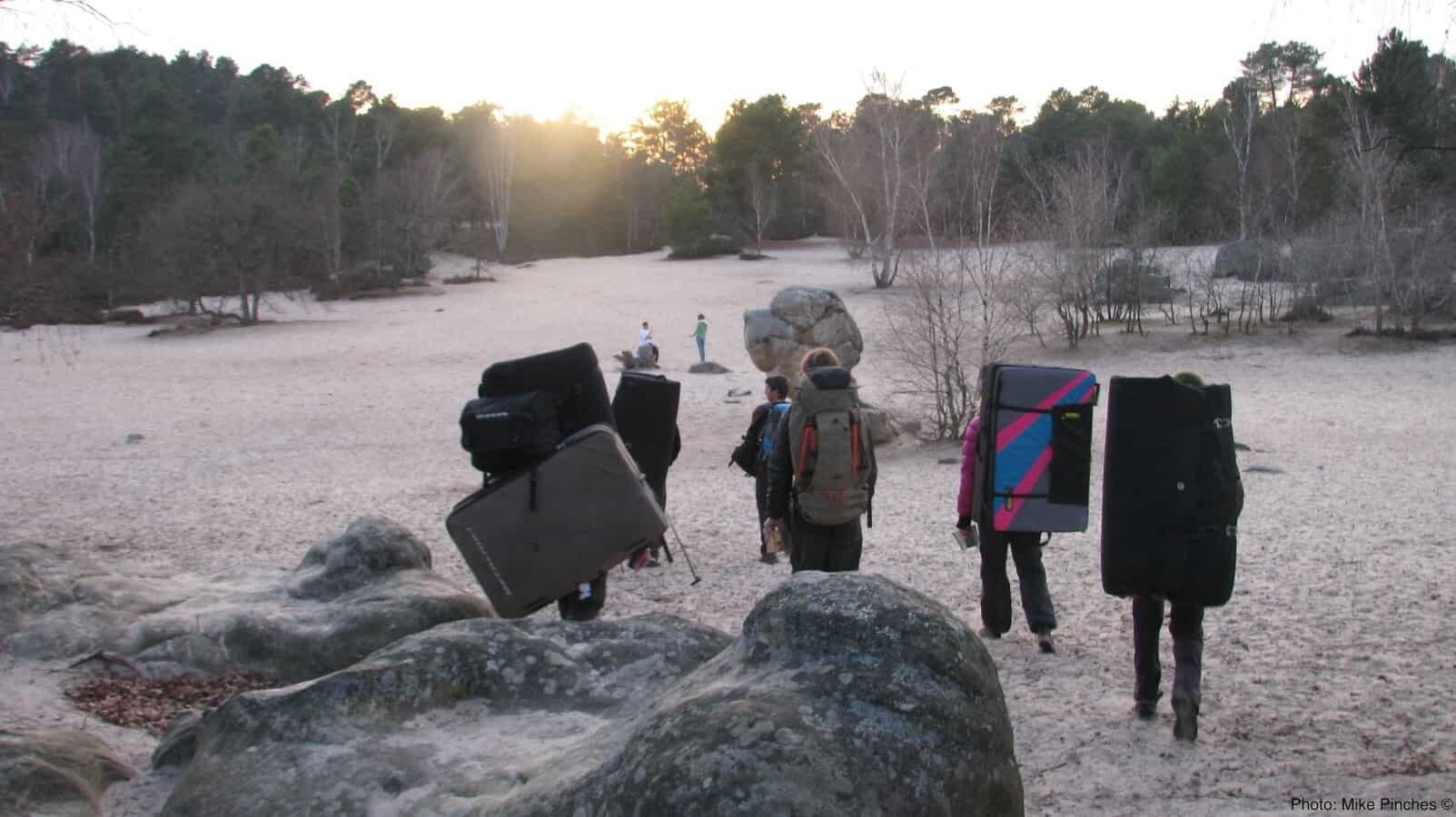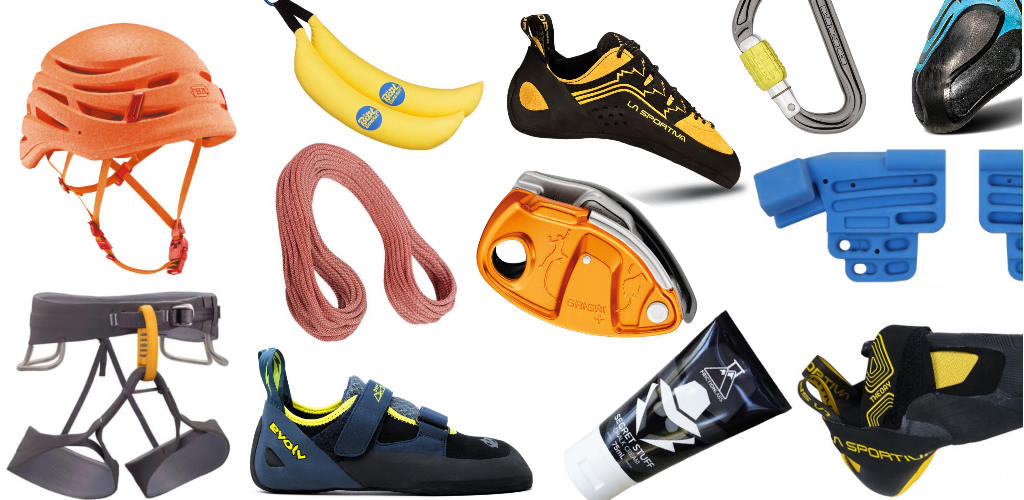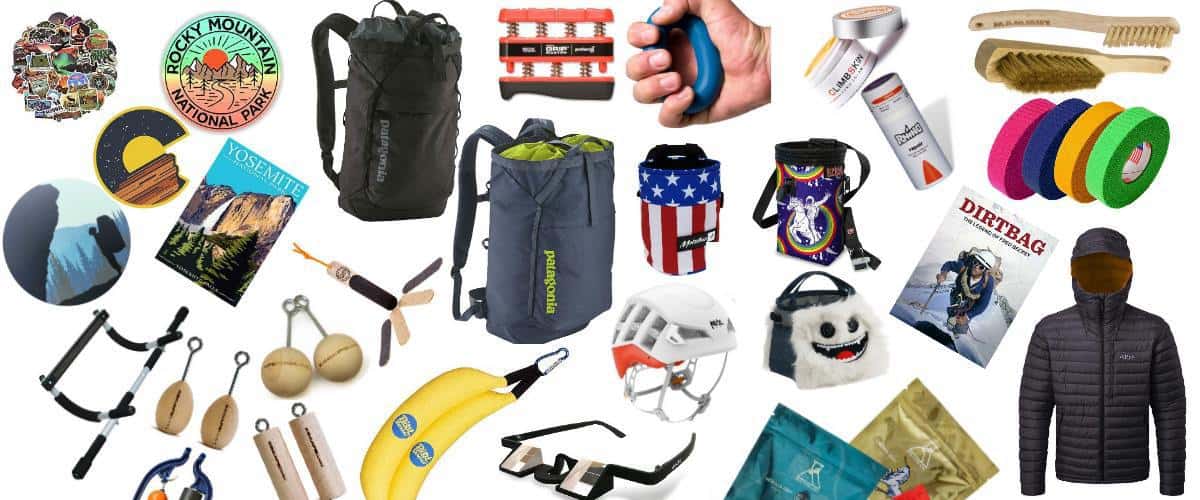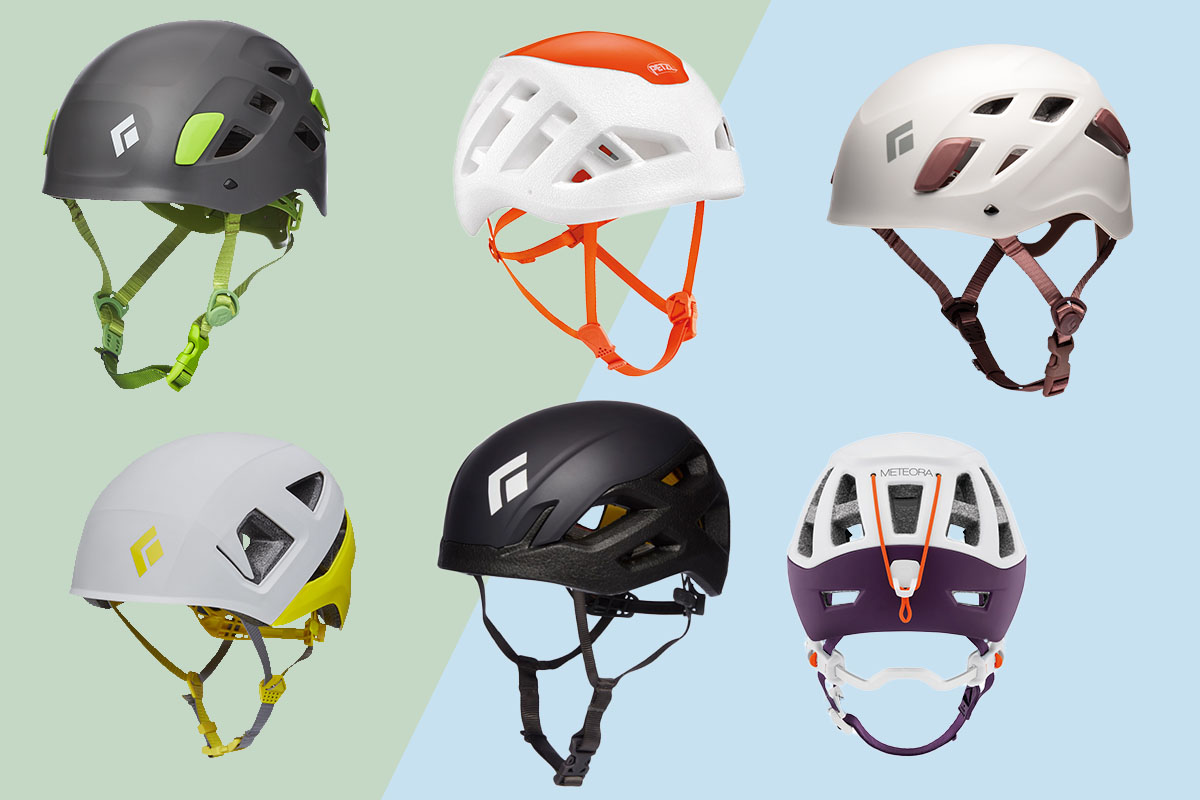Most climbers will trust their lives to carabiners without a second thought for what a kN rating actually means. However, there are some situations where carabiner strength doesn’t matter. So, how strong is a carabiner really?
How Strong Are Carabiners? – Carabiner kN Strength Ratings
Carabiners are designed to be strong enough to take huge falls over and over, without weakening, twisting, or getting damaged easily. You’d be surprised how much of a beating a carabiner can take. We’ve seen people with 30-year-old carabiners still looking untouched – though we wouldn’t recommend this.
The minimum strength for most carabiners rated for climbing is 20kN on the major axis. Carabiner strength is rated in kilonewtons (kN) as it’s a measure of force, not weight. A kilonewton is the equivalent of 225lbs of force.
How Much Weight Can A Carabiner Hold?
That means a 20kN carabiner could theoretically take up to 4,500lbs of force, or hold 4,500lbs of static weight. In theory, a carabiner could hold the weight of a car or a small, very calm rhino. When a climber falls, the forces generated are more than just your weight. Most climbing falls generate under 2 to 3 kilonewtons of force on the climber, but in rare circumstances can be up to 5 or 6 kN.
Carabiners are rated for the amount of kN they could absorb in a fall. However, there are different ratings depending on how the carabiner is pulled.
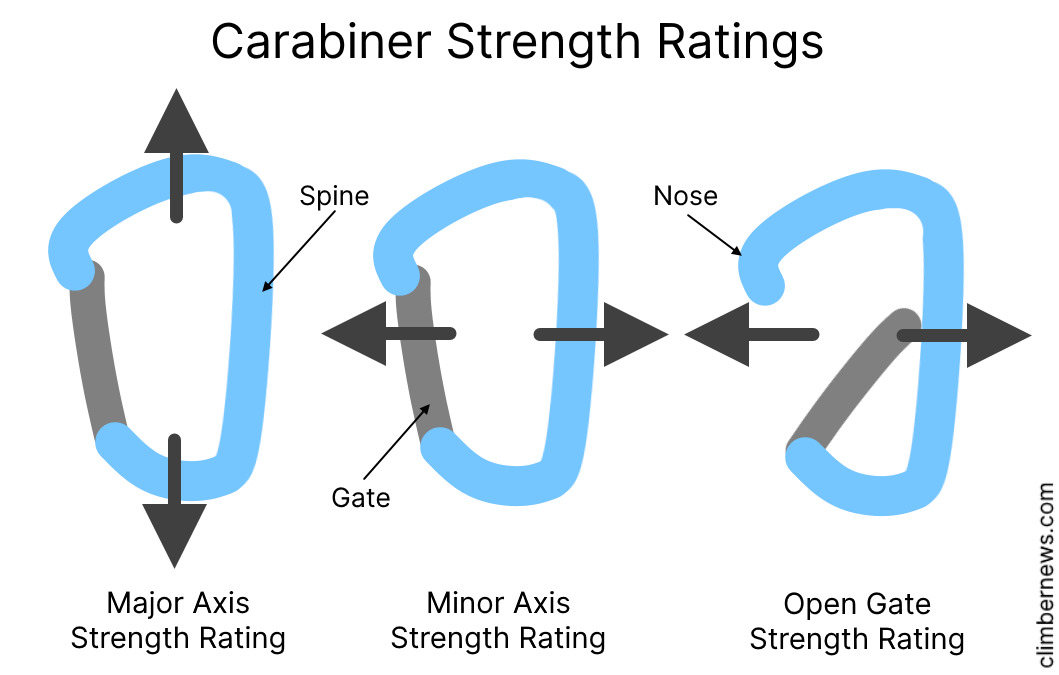
Carabiner Safety Standards
There are a few different categories of carabiner, each with slightly different standards for strength and other specifics. Most locking and non-locking carabiners climbers use will be Type B (Basic) or Type H (HMS). We’ve outlined some of the minimum safety standards for those types of carabiners below: –
- Major Axis Minimum Strength: 20kN
- Minor Axis Minimum Strength: 7kN
- Open Gate Minimum Strength: 7kN (Type B), 6kN (Type H)
- Gates must open by hand when 800 newtons of force pulls on the major axis
- Locking gates must still be functional after 10 newtons of force are applied to the fate
- Minimum gate opening width of 15mm
- Minimum force to open the gate must be at least 5 newtons
As you can see, it’s not just strength that is tested. Carabiners in the past had problems with loose gates opening when it was dangerous. Some carabiners also stopped opening when too much force had been applied. A minimum gate opening width allows for easy clipping and unclipping of a rope to the biner.
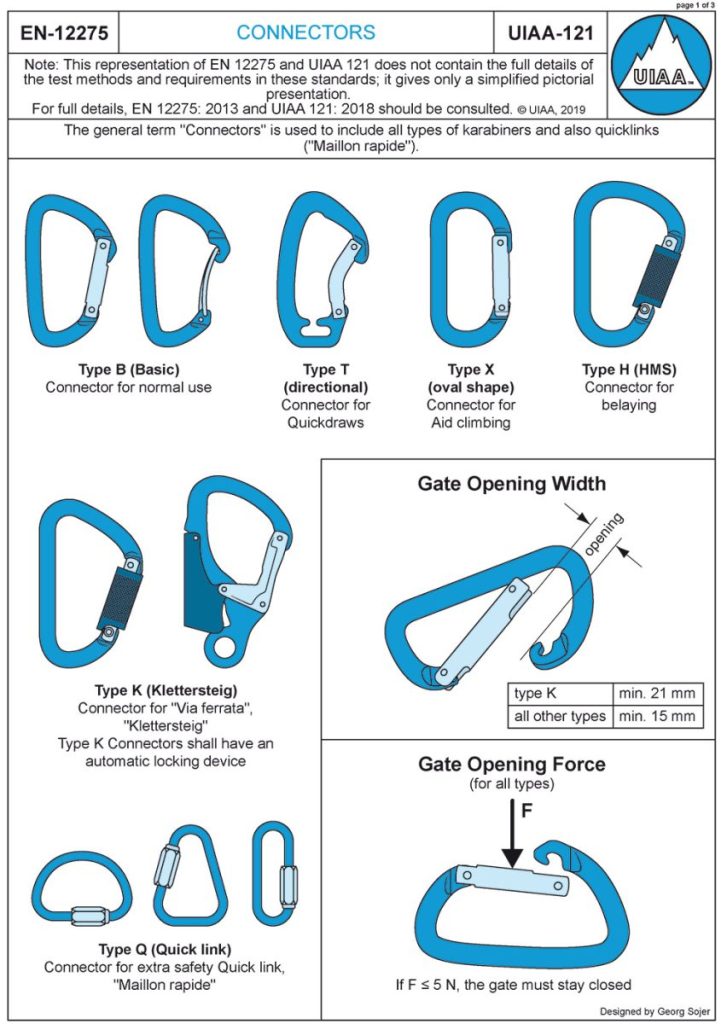
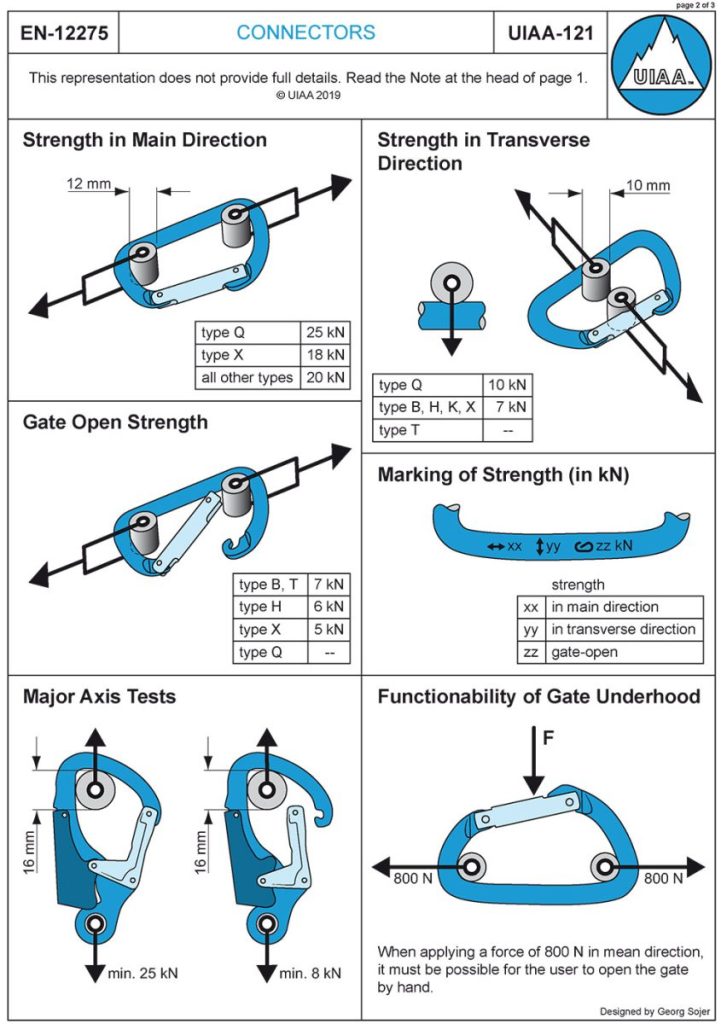
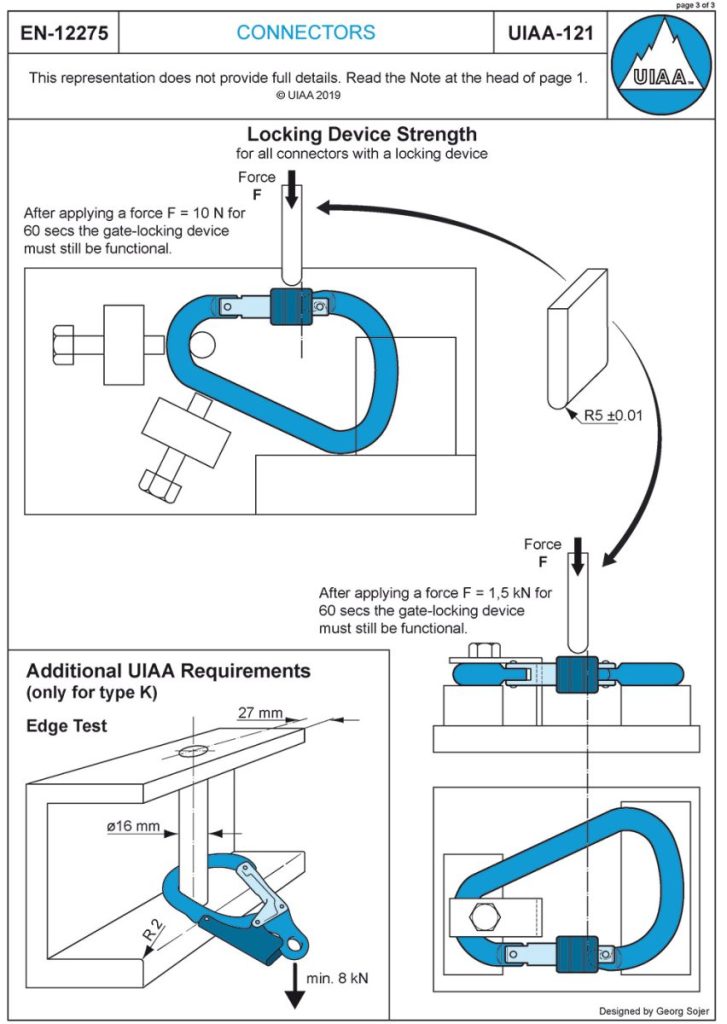
How To Read Carabiner Strength Ratings
The three different strength ratings displayed on every climbing carabiner are the Main Axis (also known as the main direction), Minor Axis (also known as transverse direction or more commonly as being cross loaded), and the Open Gate. Those must be displayed on the carabiner itself – either stamped or printed.
The numbers next to each marking are the minimum breaking strength for this specific model of the carabiner. If a manufacturer even slightly changes the design, new tests and numbers are needed.
The markings on carabiners are normally set out in the same way, with the major axis first marked by side-to-side arrows, the minor axis on up-to-down arrows, then a picture of an opened carabiner for the open gate strength. Climbing carabiners should always have a CE marking, a UIAA marking, or both.
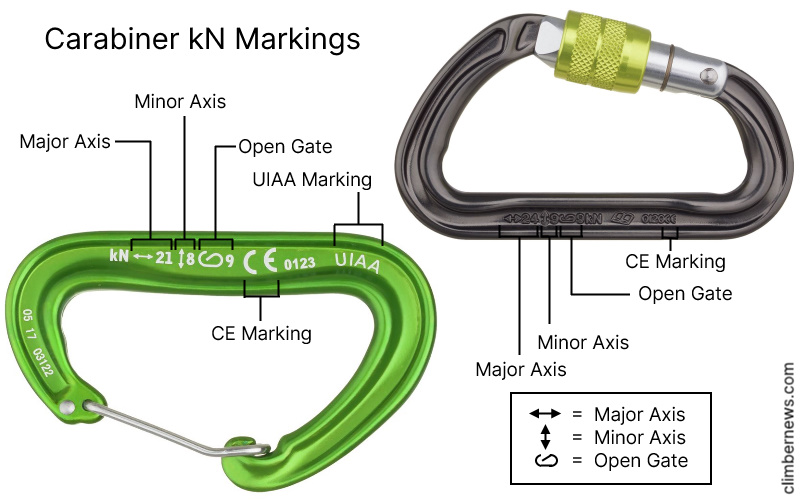
What Are Carabiner Safety Standards? CE / UIAA Markings
Carabiners sold for climbing must have passed at least one of two sets of safety standards, and show the relevant marks. The first is the EN 12275:2013 rating and a CE marking, with a code for the lab that produced the test. Carabiners can also be certified by the UIAA and show their mark.
The UIAA certifications are based on the CE ones so should be roughly the same minimum standards, with some extra conditions. Most carabiners are rated to both the UIAA and CE standards, so show both markings. If your carabiner doesn’t have at least one of these, don’t use it for climbing.
The full UIAA specifications for carabiner strength can be viewed here if you’re into that kind of thing.
How Are Carabiners Tested?
Interestingly, carabiners aren’t tested by dropping weight from them. Carabiners are tested just by pulling on each side with an industrial machine to measure at what point the biner breaks. The tests are done on the major axis, minor axis, and major axis with the gate open.
The test is always done on the same equipment and using the exact same setup. A batch of carabiners are sent off by the manufacturer to be tested by a licensed company. They break a bunch of each carabiner submitted and then create a “minimum breaking strength” number for each axis.
That is the figure used in marketing and is printed on every single one of that model of the carabiner. This figure isn’t the lowest strength that a carabiner broke at in testing, but one found using a statistical average. That means even if a carabiner is marked at 21kN of breaking strength – it could fail at a lower load.
That being said, the vast majority of carabiners will break at a higher kN value than the minimum printed on the carabiner in normal situations.
The reason for not doing drop tests is that factors like the vibration from the machine, attached ropes, and not completely vertical or perfect drops all add in too many factors to reliably measure. Individual manufacturers do their own internal break testing though.
Do Carabiners Break?
Yes, carabiners can break in climbing but normally in very specific situations. Even in a huge fall with a high impact force and fall factor, a carabiner that is loaded on its long axis will almost never break.
However, if carabiners are loaded incorrectly, they can break at much less force than rated for. Avoid these situations whenever you can. Most of the time we see carabiners break, it’s from the nose hooking on a bolt.
- Cross loaded – When a carabiner is being pulled on its minor axis (from side to side) it is at its weakest. Avoid this by keeping an eye out when you are belaying and climbing, or buy a special belay carabiner that won’t cross-load
- Nose hooking – This happens when you clip just the nose of a carabiner into something, leaving the gate open and the nose snagged. This commonly happens when clipping a quickdraw into a bolt in sport climbing. This is very bad – carabiners will break easily if loaded like this.
- Multi-Directional Loading – Most climbing carabiners are designed to be pulled in two directions, not three or more. Strength is lost when used like this to various degrees. Try to avoid
- Cantilever Loading – This often happens accidentally with quickdraws in bolts. Falls can (and have) resulted in the carabiner breaking.
- Loading Over An Edge – This can happen outdoors on badly placed bolts or with trad gear that should be extended with an extra sling. This can result in just 30% of the rated strength!
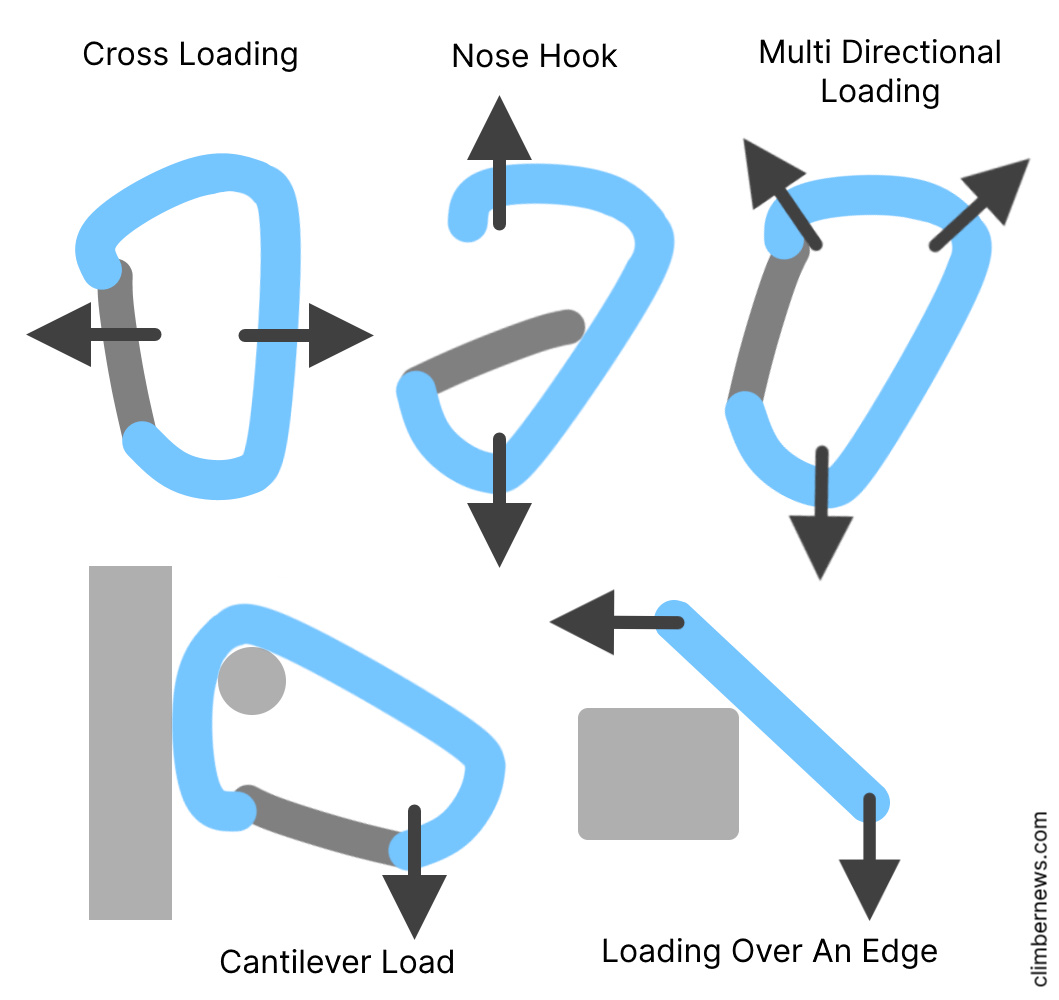
Are Bigger Carabiners Better / Stronger?
In general, larger carabiners are stronger – though not necessarily better. This is mainly because as you increase the overall size of a carabiner for handling more ropes, it’s possible to increase the thickness of the metal spine. Even with a thicker spine on a larger biner, the handling and gate opening width aren’t negatively affected.
Smaller carabiners tend to have thinner spines and less metal used but are very useful to have over larger carabiners in many situations. As soon as you need to start racking trad climbing gear, you’ll instantly realize why saving a few grams per carabiner is a good idea. Trad racks can get really heavy, very fast.
Should I Buy A Stronger Carabiner?
Most climbing carabiners have a major axis strength of 24kN and a minor and open rating of 7kN or higher. The vast majority of climbing falls will only generate 2-5 kilonewtons of force (check out some of Petzl’s tests). The minimum strengths called for by the CE and UIAA standards are pretty much always plenty.
As long as a carabiner is being used correctly with the force along the major axis, i.e. the pulls are from the top and bottom, you’ll never need anything near the minimum of 20kN. However, if you’re worried about cross-loading, try to always look for open and minor axis ratings of 8kN minimum.
For most locking carabiners – especially offset D and HMS – the major axis is 24kN or more, and the minor/open are both 8kN. This is plenty. Even for mini carabiners, 20kN or higher is more than enough for climbing. The Black Diamond LiteWire is a great small wire gate carabiner for trad and all-round use with 8kN for both the open and minor axis.
Black Diamond LiteWire Rackpack
What Is The Strongest Carabiner?
If you just want a super-strong carabiner and don’t care about weight or cool looks, the Metolius Steel screw locking carabiner is for you. With a major/minor/open axis strength of 40kN/15kN/18kN you won’t have to worry, even with insane repeated falls.
It does come in at 7.6oz, which is around three times the weight of most other locking carabiners. However, steel will last a lot longer (if kept away from salty air) and take a lot longer to show any rope damage. A couple of these are great if you make a lot of top rope anchor setups.
How Long Do Carabiners Last?
Most carabiners can happily last five to ten years of use or much longer, depending on a few factors. Most gear manufacturers don’t give a maximum age for metal products, though do recommend visually inspecting and taking responsibility for your own use.
We’ve personally used a variety of different carabiners (HMS belay, offset D in quickdraws, other utility and anchor biners) for nearly 10 years without feeling the need to replace them. But, we’ve also retired biners with significant wear or specific problems (sharp edges) after maybe 2-3 years of use.
It all depends on the use and the storage.
When Should Carabiners Be Replaced?
The best way to find out if a carabiner should be replaced is with a visual check. Age comes into play, but the major factors in replacing a carabiner are normally obvious when looking at them closely. If you see any of these signs on a carabiner you should immediately replace it: –
- Rust – Any rust on the outside of the carabiner means the inner metal has probably been weakened.
- Burrs or sharp edges where a rope can run through. It’s normal to have small burrs on the bolt side carabiner of quickdraws, but burrs and sharp parts on the carabiner where the rope runs through are bad. Ropes can cut pretty easily when running over a sharp edge on a biner.
- Large Grooves – Where a rope runs over the same areas consistently, a groove forms. When this goes past a millimeter or so, sharp edges form on the side of a groove. These can easily cut a rope in a fall.
- Gate won’t close – A sticky gate can often be cleaned but one that doesn’t snap close should be retired straight away.
- Cracks – Any cracks mean a carabiner should be replaced. Cracks generally form in areas around holes like where the rivet pin is, or near to the edges of the main body like at the nose.
- Bent – If your carabiner has suffered a bend that wasn’t there before, its structure will have been significantly weakened and should not be climbed on again.
- Loose / Damaged Rivet – Any risk of the carabiner not closing is a major problem.
- Missing Parts – Some carabiner gates have a few small parts that help the spring function. If one of these falls out, it could stop closing.
- Sea Water Damage – Anything that looks like “pitting”, or a mottled discoloring of metal means serious damage. Flaking or peeling will eventually occur. These can break with hand strength only.
- Fire Damaged – If one has been in or near a fire, it could look fine but the carabiner strength can be comprised by internal damage. Aluminum and steel don’t need to melt to be massively weakened.
If a carabiner has been stored or left near certain corrosive chemicals, you should also seriously consider replacing them. Car battery acid from leaving biners on the floor of a car, leaving them near spilled cleaning chemicals, and climbing on the coast near to the sea are three common situations.
What should be ok:
- Falls – Carabiners are designed to be loaded and fallen on. Whether it’s the biner on your cam, quickdraws, or anchor, they can take repeated falls.
- Drops – You don’t need to replace carabiners that are dropped, but it depends on what you think is safe. A drop from a few meters up might be OK, but higher than that introduces the risk of internal fractures. Any visible cracks are serious problems.
- Worn Anodizing – The color of carabiners comes from anodizing, a chemical process that turns the outer of a biner into a form of coating and coloring all in one. This anodized color can wear without any major problems – though opens it up to the elements easier.
- Slight Wear – Some scuffing and wear are OK for carabiner strength.
- Small Groove – A slight groove is the most common thing that climbers will ask about when thinking about replacing a carabiner. It depends on the design of the biner. Most manufacturers recommend replacing when the groove is 1mm or more, which is a good rule of thumb.
More Carabiner Articles
– What Is A Carabiner?
– Best Belay Carabiner
– Best Carabiner For GriGri
– How Many Quickdraws Do You Need?
Are Microfractures Real?
The buzzword in “yer gonna die” posts around the internet is microfractures. The idea is that when carabiners get dropped or hit against hard surfaces (like in everyday clumsy climber use) they sustain microscopic fractures that can reduce overall strength.
When microfractures are present in carabiners and they are dynamically loaded – loaded and unloaded over and over, common in climbing – they can break at a lower load than they are rated for. While science proves that microfractures can exist and do weaken metal, it’s not clear if this has any real working effect on dropped gear.
Without knowing exactly what drops cause microfractures and how many are needed for serious degrading of equipment, it’s hard to judge whether this is a serious concern. At the same time, “well I’ve never seen a broken carabiner after dropping it” is a classic faux pas of only relying on first-hand evidence.
A basic test for whether you should replace or retire carabiners is if there is visible damage or cracking, you shouldn’t use it again. If you should replace a biner you dropped on the padded gym floor while belaying is up to you. If you drop it from halfway up the Dawn Wall you might want to go ahead and get a new one.
Are Carabiners Secure?
Yes, locking carabiners and even non-locking ones are very good at staying closed even under great stress. Locking carabiners are obviously the better choice when you need it to stay closed. If you’re worried about carabiners on quickdraws coming unlocked, you can even keep one or two on you that have a locking biner on one side.
How Much Do Carabiners Weigh?
Carabiners vary in weight but on average a non-locking carabiner weighs around 35-36 grams, and a locking carabiner weighs about 45-60 grams. Steel locking carabiners weigh around 200 grams!
